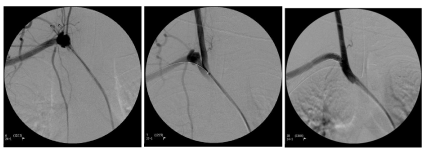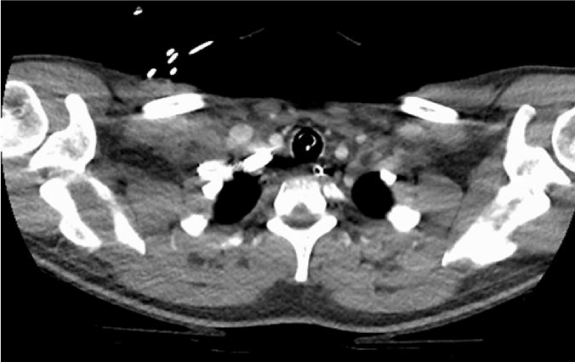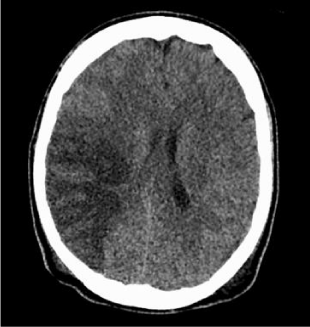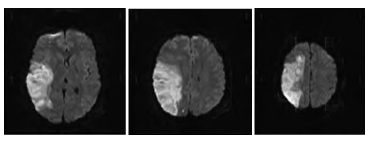Traumatic Subclavian Artery Rupture and a Complicated Repair?
Tutty-Bardon C1,2*, Collins R1,2 and Jordan E1,2
1Tallaght University Hospital
2Trinity College Dublin
*Address for Correspondence: Tutty-Bardon C, Tallaght University Hospital, Ireland, Tel: +003-538-511-248-37; E-mail: [email protected]
Submitted: 01 March 2019; Approved: 08 May 2019; Published: 10 May 2019
Citation this article: Tutty-Bardon C, Collins R, Jordan E. Traumatic Subclavian Artery Rupture and a Complicated Repair. Int J Case Rep Short Rev. 2019;5(5): 017-019.
Copyright: © 2019 Tutty-Bardon C, et al. This is an open access article distributed under the Creative Commons Attribution License, which permits unrestricted use, distribution, and reproduction in any medium, provided the original work is properly cited
Download Fulltext PDF
Subclavian arterial injury is rare with a reported incidence of less than 1% of all arterial injuries or thoracic traumatic injuries [1]. The complications are potentially life threatening, requiring urgent intervention especially when it causes arterial occlusion to prevent limb ischaemia and retrograde thromboembolisation causing cerebral infarction. In the following case our patient had a traumatic rupture of his subclavian artery and underwent stenting from the birfurcation of the brachocephalic trunk to the axillary artery.
A 23 year old man was brought to a General Hospital ED following an RTA in which his vehicle hit a stone bridge. CT demonstrated multiple injuries, including 4-6th rib fractures, right talus fracture, and a right subclavian artery rupture. He was transferred for operative management of the rupture and was haemodynamically stable on arrival with no neurological deficit.
During attempted extubation, patient was noted to have new dense left hemiparesis and GCS of 3/15. He was re-intubated due to failure to maintain his airway. CT brain demonstrated a new large hypoattenuation in the Right temporoparietal lobe, in the Posterior MCA vascular territory, in an embolic pattern. Following weaning of sedation and extubation his neurological deficit resulting from the infarction became evident. He had left sided weakness in upper and lower limbs, more pronounced distally. Left homonymous hemianopia, mild dysarthria, moderate dysphagia, decreased sensation on the left side and a left sided tactile inattention.
This case demonstrates the rare occurrence of subclavian artery rupture due to blunt trauma and one of the complications which can occur- perioperative stroke. In this case despite early intervention in the patient suffered a serious complication. The patient required transfer for urgent treatment, which caused a delay highlighting the need for centralised acute trauma centres.
Introduction
Subclavian arterial injury is rare with a reported incidence of less than 1% of all arterial or thoracic traumatic injuries. The complications are potentially life threatening, requiring urgent intervention to prevent limb ischaemia and retrograde thromboembolisation causing cerebral infarction. In the following case our patient had a traumatic rupture of his subclavian artery and underwent stenting from the bifurcation of the bracho-cephalic trunk to the axillary artery.
Case
23 year old man brought to a General Hospital ED following an RTA in which his vehicle hit a stone bridge. CT demonstrated that multiple injuries were sustained including 4-6th rib fractures, right talus fracture, and a right subclavian artery rupture and right sided axillary artery aneurysm. He also had a small right sided pneumothorax. He was transferred to a vascular specialist unit for urgent operative management of the rupture as the complications of an untreated subclavian artery rupture are potentially devastating or life threatening. He was haemodynamically stable on arrival with no neurological deficit, and his GCS was 15/15.
He was consented, and informed of the risks, including the risk of posterior circulation stroke due to planned occlusion of the vertebral artery. The procedure was carried out in an operating theatre, and the procedure was carried out percutaneously. Endovascular access was gained via the femoral artery. A stent was placed from the bifurcation of the brachiocephalic trunk to the axillary artery. During stent placement the vertebral artery was occluded, and the patient was noted to have a dominant Left vertebral artery. The procedure was successful and the intraoperative course was uncomplicated. He also underwent open reduction and fixation of his right tibial fracture, talus fracture, and knee washout.
During attempted extubation the following day, the patient had stridor and he was found to have a new dense left hemiparesis and GCS of 3/15. He could not maintain his airway and reintubation was required. CT brain demonstrated a new large hypoattenuation in the right temporoparietal lobe with loss off grey white matter differentiation. This was in the posterior MCA vascular territory, in an embolic pattern. There was no mass effect and no evidence of intracranial haemorrhage. CT angiogram did not demonstrate any large vessel occlusion. The R sided subclavian artery stent was in situ with appropriate distal patency and opacification. He was reviewed by a stroke consultant and received a 300 mg dose of aspirin.
Chest X ray showed widening of the superior mediastinum, a small right apical pneumothorax and increased opacification throughout the right lung, especially in the right upper lobe- likely infectious or inflammatory secondary to aspiration, and the left lung was grossly clear.
The following day he had an MRI brain, which confirmed a large acute right sided frontoparietal infarct with FLAIR hyperintensity and restricted diffusion. There was moderate local sulcal effacement, mild midline shift of approximately 6 mm, partial effacement of the right lateral ventricle, no hydrocephalus.
His chest x-ray showed improvement in the pneumothorax and opacification following chest drain insertion, and it had fully resolved 3 days after insertion of chest drain. However he had some persistent consolidation in RUL and Left basal atelectasis.
He was assessed by the orthopaedic team for C spine clearance and Miami J collar was removed.
On day 5 post-op he failed extubation again and CT brain was preformed to exclude interval change- however the extent of the R MCA infarct had remained unchanged since the MRI.
He was successfully extubated 2 days later on day 7 of admission, with an NG tube in Situ, Chest drain was removed. He remained intubated for 7 days. Following weaning of sedation and extubation, his neurological deficit became apparent. He had left sided weakness in upper and lower limbs, more pronounced distally. Left homonymous hemianopia, mild dysarthria, moderate dysphagia, decreased sensation on the left side and a left sided tactile inattention. His NIHSS was 14. He had an MRI brain 2 days after initial CT brain.
The stroke aetiology was deemed to be a retrograde thromboembolic event which occurred at the time of stent placement due to dislodgment of thrombus. Diagnostic investigations to search for other causes revealed normal carotid and lower limb dopplers, no potential embolic source on TOE and he was in normal sinus rhythm throughout his stay on telemetry.
He spent 10 days in PACU, and was transferred to the ASU following removal of the NG tube, chest drain and femoral Line. He remained in hospital for 6 weeks undergoing intensive rehabilitation. He required further knee washouts, and required IV tazocin for treatment of a Hospital acquired pneumonia during his stay from which he recovered well. He following this he was transferred back to the regional hospital to continue his rehabilitation closer to home. He was mobilising with a self-propelling wheelchair at that time his fine motor movements in his hand were also improving and he was eating normal diet.
Discussion
Subclavian artery rupture due to blunt trauma is a rare injury, with a reported incidence of less than 1% of all arterial injuries or thoracic traumatic injuries [1]. In motor vehicle accidents, as in this case, elongation injuries occur due to blunt force to the anterior shoulder or clavicle. This causes the vessel to be pulled apart when the force is transmitted to fixed points along the vessel, typically the origin of the vertebral and internal thoracic artery. In clavicular or first rib fractures bony fragments cause laceration to the subclavian artery [2].
In this case the tear from the origin of the subclavian artery to the axillary artery was detected on CT thorax preformed as part of a trauma series. Options for repair include open or endovascular repair and open repair. Endovascular repair is less invasive, there is less blood loss, and avoids dissection of the traumatised area, also decreasing the risk of injuring surrounding structures [3]. There are high success rates if the lesion is focal.
If the vessel is completely transected and there is an associated haematoma then there can be difficulty achieving complete vessel traversion with a guidewire [4]. Vessel transection may therefore require open repairIn recent years more and more cases are being repaired with an endovascular approach- with new endovascular techniques and extending the indication for endovascular management to include haemodynamically unstable patients as well as complete vessel transection. Ideally patients should be managed in a setting where endovascular and open techniques can be used [5].
This case demonstrates the rare occurrence of subclavian artery dissection due to blunt trauma and one of the complications which can occur during endovascular repair. Urgent treatment is required to prevent complications of a subclavian artery rupture. In this case despite early intervention in the patient suffered a serious complication from the injury during the repair of the vessel due to dislodgment of thrombus during stent placement. The patient required transfer, highlighting the need for designated acute trauma centres.
- Franz RW. Delayed treatment of a traumatic left subclavian artery pseudoaneurysm. Vasc Endovascular Surg. 2008; 42: 482-485. https://bit.ly/2H73nC1
- Kendall KM, Burton JH, Cushing B. Fatal subclavian artery transection from isolated clavicle fracture. J Trauma. 2000; 48: 316-318. https://bit.ly/305otby
- Castelli P, Caronno R, Piffaretti G, Tozzi M, Lagana D, Carrafiello G, et al. Endovascular repair of traumatic injuries of the subclavian and axillary arteries. Injury. 2005; 36: 778-782. https://bit.ly/2PUtpLs
- Xenos ES, Freeman M, Stevens S, Cassada D, Pacanowski J, Goldman MJ. Covered stents for injuries of subclavian and axillary arteries. Vasc Surg. 2003; 38: 451-454. https://bit.ly/2H9bdtw
- Assenza M, Centonze L, Valesini L, Campana G, Corona M, Modini C. Traumatic subclavian arterial rupture: a case report and review of literature. World J Emerg Surg. 2012; 7: 18. https://bit.ly/2DUVI7L





Sign up for Article Alerts